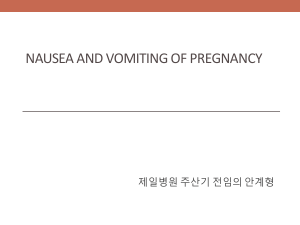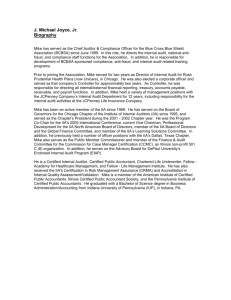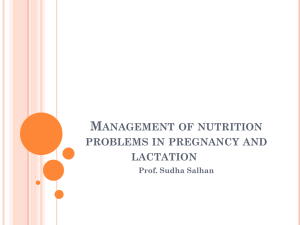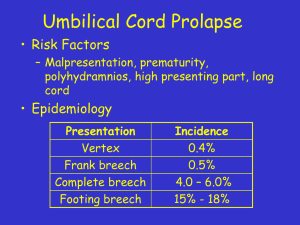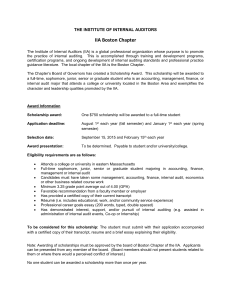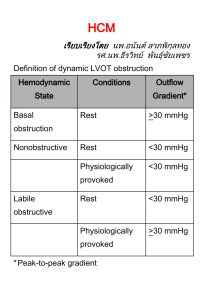7 NGF Obst hyperemisis Vikanes
advertisement
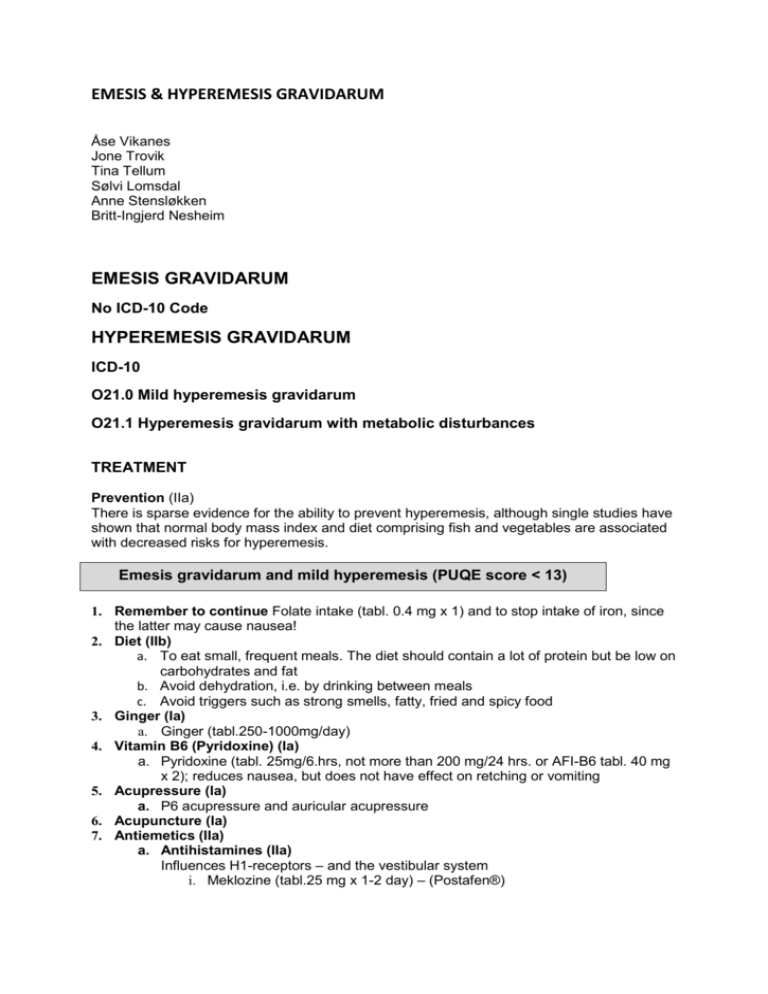
EMESIS & HYPEREMESIS GRAVIDARUM Åse Vikanes Jone Trovik Tina Tellum Sølvi Lomsdal Anne Stensløkken Britt-Ingjerd Nesheim EMESIS GRAVIDARUM No ICD-10 Code HYPEREMESIS GRAVIDARUM ICD-10 O21.0 Mild hyperemesis gravidarum O21.1 Hyperemesis gravidarum with metabolic disturbances TREATMENT Prevention (IIa) There is sparse evidence for the ability to prevent hyperemesis, although single studies have shown that normal body mass index and diet comprising fish and vegetables are associated with decreased risks for hyperemesis. Emesis gravidarum and mild hyperemesis (PUQE score < 13) 1. Remember to continue Folate intake (tabl. 0.4 mg x 1) and to stop intake of iron, since the latter may cause nausea! 2. Diet (IIb) a. To eat small, frequent meals. The diet should contain a lot of protein but be low on carbohydrates and fat b. Avoid dehydration, i.e. by drinking between meals c. Avoid triggers such as strong smells, fatty, fried and spicy food 3. Ginger (Ia) a. Ginger (tabl.250-1000mg/day) 4. Vitamin B6 (Pyridoxine) (Ia) a. Pyridoxine (tabl. 25mg/6.hrs, not more than 200 mg/24 hrs. or AFI-B6 tabl. 40 mg x 2); reduces nausea, but does not have effect on retching or vomiting 5. Acupressure (Ia) a. P6 acupressure and auricular acupressure 6. Acupuncture (Ia) 7. Antiemetics (IIa) a. Antihistamines (IIa) Influences H1-receptors – and the vestibular system i. Meklozine (tabl.25 mg x 1-2 day) – (Postafen®) ii. Prometazine (tabl./inj./i.m.25 mg evening, or 25 mg x 2-3 per os) – (Phenergan®) b. Dopamine (D2-receptor) antagonists (IIa) i. Proklorperazine (tabl.5-10 mg x 2-3 day. /alternatively 25 mg x 1 sup) – (Stemetil®). Caution: risk for lowering blood pressure during the last trimester and during labor ii. Chlorpromazine (tabl.10 mg x 2-3 day/i.v. infusion 25 mg in 1000 ml 5% Glucose over 24 hours)- (Largactile®). Caution during last trimester c. Metoclopramide (Dopamine antagonist (D2)/regulates motility) (IIa) i. Metoclopramide (tabl./supp10-20 mg x 3/) – (Afipran®); Due to EU guidelines:do NOT administer more than 5 days 8. Alleviate dyspepsia - proton-pump inhibitor (IIb) a. Omeprazole (tabl.20 mg x 1) – (Losec®) 9. Vitamin B1 (IIa) a. Thiamine (Vitamin B1) (100 mg in 100 ml 0.9 % Sodium-Chloride given over ½-1 hrs.) if severe symptoms have lasted for more than 2 weeks. Can be repeated. Hyperemesis gravidarum with metabolic disturbances (PUQE score ≥ 13 points) 1. Hospital admission or outpatient ward? This decision is always based on individual evaluation; but is also dependent on arrangements in each hospital. 2. Diet (IV) The woman should be allowed to eat and drink if possible. There is no evidence that fasting may be beneficial for these patients. 3. Rehydration (IIa) Start by administering 2L Ringer-acetate or isotone Sodium-Chloride intravenously over 3-5 hrs. Add if necessary Potassium-Chloride, Magnesium-Sulfate, CalciumGluconate, phosphate and thiamine. A minimum urine output of 1000ml/24h is aimed for. For maintenance: 1L Sodium-Chloride or Ringer-acetate daily until the patient is drinking and eating. Glucose can only be administered after thiamine has been administered; otherwise there is an increased risk of developing Wernicke’s encephalopathy. Caution also by correcting hyponatremia (<120mmol/l); due to risk of central pontine myelinolysis, or by correction of hypokalemia due to risks for cardiac arrhythmias. 4. Vitamin supplements (IIa) a. Thiamine (Vitamin B1) – see above. 5. Antiemetics (IIa) a. Antihistamines, dopamine antagonists and metoclopramide – see above; alternatively b. Serotonin antagonists (IIa) i. Ondansetron (tabl.4-8 mg x 2 per os/alternatively 4mg x 2 i.m.) (Zofran); caution due to possible increased risk of cardiac septum defect. c. Glucocorticoids (IIa) Methylprednisolone (tabl.40 mg per os/or i.v. the first 3 days, thereafter gradual reduction by halving the doses every 3. day). If no effect after 3-4 days, there should be cessation of medication. Caution during 1.trimester, and should be administered after 10th gestational week only due to increased risk for lip-palate cleft. 6. Nasogastric or nasojejunal tube (III) Should be considered if the condition is not improving and there is maternal weight loss. A nasojejunal tube can be administered by use of gastroscopy. Basic nutritional need per 24 hrs; the woman’s body weight x 30= ml/24hrs. 7. Parenteral nutrition (IIa) Partial parenteral nutrition can be administered over shorter periods of time simultaneously to correcting fluid and electrolyte disturbances, and during initiation of nutrition by nasogastric or nasojejunal tube. 8. Prophylaxis against thromboembolism (IIa) 9. Follow up (IV) Mesh words and literature research strategy Emesis gravidarum, hyperemesis gravidarum, nausea and vomiting in pregnancy Pyramide search, UpToDate, BMJ Best Practice, RELIS, Embase <1980 to 2012 Week 27>, Ovid MEDLINE(R) In-Process & Other Non-Indexed Citations, Ovid MEDLINE(R) Daily and Ovid MEDLINE(R) <1946 to Present>, PsycINFO <1967 to July Week 1 2012> Definitions and prevalnce Emesis gravidarum Proximately 90% of pregnant women experience some degree of nausea and/or retching and vomiting, where 35% feel affected physically and/or psychologically (6,14). Hyperemesis gravidarum (Hyperemesis) In Norway hyperemesis affects 1% of all pregnant women, causing long-lasting nausea, retching and vomiting. Hyperemesis is defined as symptom-debut before the 22nd gestational week, and most often symptom debut between 4th and 9th gestational week although 10 to 20% have symptoms after 16th week (1-4). In severe cases hyperemesis causes metabolic disturbances, including weight loss, dehydration, ketonuria and electrolyte imbalances. The aetiology remains unknown (1). Epidemiology and risk factors Hyperemesis is associated with young maternal age, low education, non-smoking, lower or higher body mass index than normal (< 18.5 kg/m2 or > 29.9 kg/m2) and having non-western origin (4-6). Compared to women who never experienced hyperemesis, women with hyperemesis in one pregnancy are 26 times more likely to suffer from this in their next pregnancy (7). Daughters of mothers with hyperemesis in one of her pregnancies are three to four times more likely to develop hyperemesis, compared to daughters of mothers who never experienced hyperemesis (8). Furthermore hyperemesis is associated with female fetuses, multiple gestations and molar pregnancy (5). Clinical findings Nausea, retching and increased saliva production Weight loss and dehydration Low sodium, hypokalemia, hypochloraemia, low urea Ketosis and ketonuria Metabolic alkalosis Increased liver transaminases in proximately 50 % of cases 2/3 has pathological thyroid tests (biochemical increased levels of FT4 and low TSH). These patients do not need any specific endocrine treatment. Differential diagnoses (hyperemesis is a diagnosis of exclusion!) Urine infections Gastrointestinal diseases, such as gastroenteritis, appendicitis, hepatitis, pancreatitis, cholecystolithiasis, gastric ulcer and acute fatty liver Endocrine diseases, such as hyperthyroidism, hyperparathyroidism, diabetes and porphyria Neurological diseases, such as brain tumor Vestibular lesions and medicament intoxication Psychological diseases, such as eating disorders Examinations General clinical examination with blood pressure, pulse and signs of dehydration Ultrasound (Vital intrauterine fetus? Multiple gestations? Molar pregnancy?) Maternal weight measured on individual basis, minimum twice a week Measurement of diuresis and fluid intake in severe cases; measure until 24 hour diuresis is > 1000 ml including no ketonuria Hemoglobin, Hematocrit, Sodium, Potassium, Chloride, Creatinine, Albumin, Prealbumin, ASAT, ALAT, LD If clinical hyperthyroidism is suspected: TSH, FT4 Magnesium, Phosphorus and Calcium when long-lasting disease PUQE In order to be able to measure the magnitude of suffering from NVP and Hyperemesis and monitor the effect of treatment, Pregnancy-Unique Quantification of Emesis and nausea (PUQE) has been developed. PUQE measures the intensity of symptoms, and provide a better basis for diagnostics and objective evaluation of treatment. 1: During the last 24 hours, for how long have you felt nauseated or sick to your stomach? Not at all 1 hour or more 2-3 hours 4-6 hours More than 6 hours 1 point 2 points 3 points 4 points 6 points 2: During the last 24 hours, have you vomited or thrown up? More than 7 times 5-6 times 3-4 times 1-2times 5 points 4 points 3 points 2 points I did not throw up 1 point 3: During the last 24 hours, how many times have you had retching or dry heaves without bringing anything up? None 1-2 times 3-4 times 5-6 times More than 7 times 1 point 2 points 3 points 4 points 5 points Mild nausea and vomiting (NVP): 3-6 points, Moderate NVP: 7-12 points, Severe NVP: 13+ points Evaluation of wellbeing: On a scale from 0 to 10, how would you rate your wellbeing right now;……………… 0= worst imaginable; 10 = as well as I was before pregnancy.


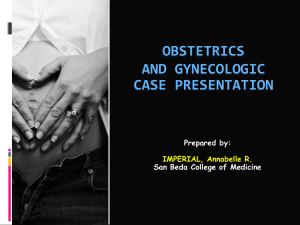
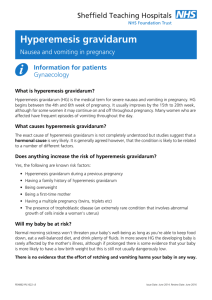
![[Physician Letterhead] [Select Today`s Date] . [Name of Health](http://s3.studylib.net/store/data/006995683_1-fc7d457c4956a00b3a5595efa89b67b0-300x300.png)
